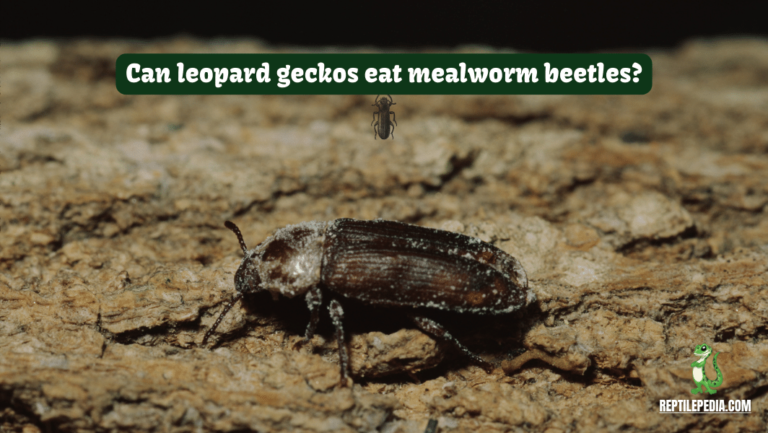When it comes to leopard geckos and their diet, a common question is whether they can consume mealworm beetles and darkling beetles. The answer largely depends on the individual gecko. While some geckos may find the beetle a bit difficult to chew, especially when compared to softer insects like crickets, others will nibble away without any issues. It’s fascinating to note how these preferences are determined by each gecko’s unique eating habits. Explore the dietary relationship between Leopard Geckos and Mealworm Beetles in this comprehensive guide.
Fortunately, for reptile enthusiasts, beetles are simple to breed, which makes them a cost-effective option. They’re a popular choice not only for geckos but for numerous other reptiles and animals that love to eat them. This can help central defenders in the reptile community to save money on food. If you decide to feed your gecko mealworms, it’s advisable to place them in a sandwich bag with a calcium supplement and shake it violently.
This ensures that the mealworms’ guts are full of calcium, vital for your gecko’s health. However, always remove any uneaten items as soon as possible to avoid any unpleasant odors or bites if your gecko doesn’t like them.
Table of Contents
What are mealworm Beetles?
Mealworm beetles, native to tropical lands and often found in wooden places, are a fascinating species for any enthusiast. With over 15000 species, they present a varied diet option for leopard geckos. These beetles, recognized by their harder shell on the body, can grow up to 1.5 inches in size. Interestingly, they can’t fly, making them an easy prey for leopard geckos, though some geckos might find them difficult to eat due to their size and shell hardness.
Their lifecycle starts as newly born mealworm beetles larvae, which are soft and easily eatable, making them particularly good for young geckos. The larger mealworm beetles, while more challenging to consume, are a good source of nutrients. Research shows they contain about 18% proteins and 10% fat, making them a suitable addition to a healthy, nutrient diet for geckos. These qualities ensure that mealworm beetles, in their various life stages, provide a comprehensive dietary option for your reptile pets.
Lifecycle of Mealworms and Their Transformation
The journey of a mealworm to become a mealworm beetle is a remarkable process. Typically, within two to three weeks after it has pupated, a darkling beetle emerges, marking a significant transformation. The initial egg stage of a mealworm spans approximately 7 to 14 days, but factors like low temperatures and high humidity can significantly treble the incubation period. This phase of development is crucial, as the environmental conditions can greatly influence the time it takes for a mealworm to reach its beetle stage.
The lifecycle of these creatures is not only intriguing for those interested in entomology but also important for pet owners, especially those with leopard geckos, as these beetles become part of their diet. Understanding this cycle helps in providing the right nutrition at different stages of a gecko’s life.
Mealworm Life Cycle

Contrary to what their name suggests, Mealworms are not worms but rather the larvae of the darkling beetle belonging to the Tenebrio Molitor genus. Fascinatingly, there are over 20,000 varieties of darkling beetles, each undergoing complete metamorphosis through four life stages: eggs, pupa, and eventually maturing into adults. The duration each mealworm spends in a particular stage can differ significantly, influenced by various environmental elements like temperature, moisture, food, and water availability.
This intricate life cycle makes mealworms a subject of interest not just for enthusiasts but also for owners of birds, reptiles, and other creatures who rely on these larvae as a crucial part of their diet. Understanding these stages is particularly important for leopard gecko owners, ensuring their pets receive appropriate nutrition at each developmental phase of the mealworm.
The Egg Stage
The first stage of a mealworm’s existence begins as an egg, so tiny in size that it’s comparable to a dust particle. Remarkably, each egg takes the shape of a white bean and has a certain stickiness, allowing dirt, dust, and debris to cover it, offering a form of natural camouflage. This stage is crucial for the lifecycle, as the hatching of a larva from these eggs marks the beginning of a mealworm’s journey.
The time taken for a mealworm to emerge from its egg varies, typically ranging from one to four weeks, depending on environmental conditions. Understanding this phase is vital for leopard gecko owners, as it influences the nutritional value of these insects when they are used as feed.
The Larval Stage
In the second stage of its life, a mealworm transforms into a brown larva. This stage typically lasts eight to ten weeks. After hatching, the larva starts quite small but eventually grows to a length of about one and a half inches. The worm must molt multiple times, around ten to twenty instances during this period, to lose its hard exoskeleton and grow. Each molt leaves the mealworm with a recently molted, fragile, and whitish exoskeleton that will soon stiffen.
This process is vital for feeding and growing, as the larva stores energy for its impending transition to the next stage. For leopard gecko enthusiasts, understanding the larval stage is crucial, as the nutritional content of mealworms varies significantly during this period, impacting their suitability as a food source for the reptiles.
The Pupal Stage
Following its last molt, a mealworm undergoes a dramatic change to become an alien-looking, white pupa. This is a critical stage of life, lasting from one to 3 weeks. During this phase, the pupa is quite vulnerable, as it cannot eat and lacks both a mouth and an anus. Despite having legs and wing buds, these are inactive at this stage, leaving the pupa able to do little more than wiggle and appear completely helpless.
This transformation is crucial, as the pupa develops its adult body and organs in preparation for its final metamorphosis into a darkling beetle. Understanding this stage is vital for leopard gecko owners, as the pupal stage represents a period when mealworms are not suitable for feeding, given their lack of mobility and nutritional changes.
The Adult Stage
The final stage of the insect’s life cycle is when the mealworm transforms into an adult darkling beetle. This stage typically lasts one to three months. At first, the exoskeleton of the newly emerged white beetle is soft, but it gradually hardens, turning from brown to black. Despite having strong wings, these beetles cannot fly. During adulthood, which begins within one to two weeks of reaching this stage, beetles engage in mating and reproducing.
Female beetles are particularly noteworthy as prolific breeders, capable of producing hundreds of eggs throughout their adult life. For leopard gecko enthusiasts, understanding this stage is crucial, as adult beetles offer different nutritional values and challenges in feeding compared to their larval or pupal forms.
How To Store Mealworms?
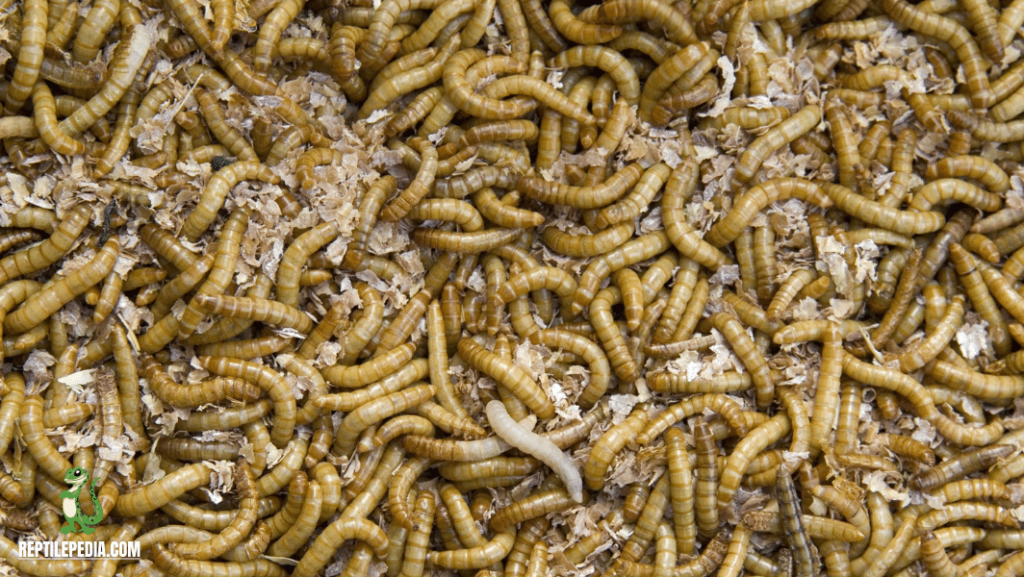
When considering the dietary needs of leopard geckos, particularly their consumption of mealworms, it’s crucial to understand the best methods for storing these critters. As a gecko enthusiast, I’ve learned that there are two ways to effectively store mealworms. The first method involves keeping them in a cold environment. This approach helps to stop the mealworms from developing into a pupa or a darkling beetle. It’s a strategy I often use when I want to slow down their growth cycle.
Alternatively, if the goal is to maintain a warm environment, this will encourage the mealworms to grow and eventually pupate and change into beetles, which can also be a nutritious part of a gecko’s diet. This dual approach to mealworm storage ensures that whether you’re halting their development or encouraging their growth, you have the flexibility to cater to your pet’s needs.
Simplifying Mealworm Storage for Gecko Owners
When it comes to feeding leopard geckos, a key aspect is managing mealworms effectively. From my personal experience in herpetology, the ideal setup involves using open, shallow containers to prevent escape. The container, which can be glass or plastic, needs to be positioned with about one inch of substrate. This can be a simple, clean layer like Josh’s Frogs Mealworm Bedding or a 3-inch coating of mealworm maintainer substrate. For the mealworm tank, regular cleaning and drying are crucial.
The bedding also serves as nourishment, so incorporating finely ground grain or oats is beneficial, allowing the mealworms to dig down and spread out. A larger container is preferable, and the substrate should be changed at least once a week to maintain optimal conditions.
Keeping Mealworms Healthy and Alive
A crucial aspect in feeding leopard geckos is to keep mealworms healthy and vibrant. In my experience as a reptile enthusiast, the key lies in managing their climate. Maintaining a natural temperature around 70℉ is ideal. At this temperature, mealworms not only consume their food more effectively but also expand and grow quickly, eventually becoming a pupa. This temperature range keeps them sufficiently active, ensuring they reach the pupal stage in around 3 weeks. Such precision in climate control is fundamental for the well-being of mealworms and, consequently, the health of the leopard geckos that feed on them.
Keeping Mealworms Dormant and Cold
In the context of feeding leopard geckos, it’s crucial to understand how to keep mealworms in a dormant state. Placing them in a fridge at temperatures between 45-50℉ effectively delays their transformation into a pupa or darkling beetles. This refrigerated approach is something I’ve found essential when storing mealworms for extended periods, up to 6 weeks. However, it’s important to remember that when fed to a leopard gecko, these chilled mealworms shouldn’t be used immediately from the fridge. Since they won’t eat in a chilly state and might starve, it’s better to allow them to eat well and return to room temperature beforehand. This ensures your gecko gets the most nutritional value from the mealworms.
Is Feeding Mealworm Beetles Safe For Geckos?
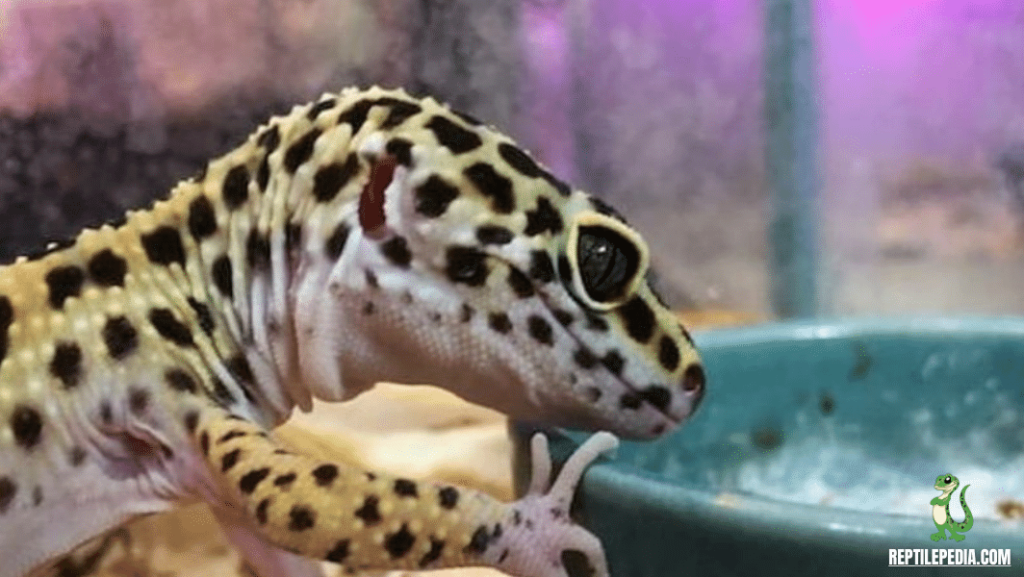
The safety of feeding mealworm beetles to leopard geckos, often referred to as Leos, is a nuanced topic. Newly born and younger mealworm beetles are generally safe to feed to Leos. However, the large size of adult beetles can cause problems, like throat or stomach problems in geckos. This is due to their harder shell and body, which can lead to choking hazards, especially in young, small geckos. To mitigate this, I recommend small mealworms or soft mealworm beetles, which are easier for Leos to manage with their jaws. Adult mealworm beetles, when eating, can potentially injure the mouth or throat of a gecko, so it’s better to avoid these to prevent any problems.
For a balanced approach, consider the nutritional content of mealworm beetles. They offer a high amount of proteins but a low amount of fat, along with calcium, making them good feeders for geckos. To ensure easier consumption and digestion, feed your gecko by cutting the beetle’s body into 2 or 3 parts. This allows them to eat and digest the beetles more easily, serving the purpose of a healthy diet that helps them live a healthy life.
How to Feed Mealworms to Leopard Geckos? Leopard Geckos and Mealworm Beetles
Feeding mealworm beetles to leopard geckos can be a nutritious addition, as these beetles are rich in proteins and calcium. However, it’s vital to maintain the size of the beetles in their diet. While darkling beetles (the adult form of mealworms) can be added to the regular diet of a gecko, their size and harder shells make them more difficult to chew and digest. To ensure your gecko can safely consume these beetles, it’s crucial to select ones that are appropriate in size and not too challenging for the gecko to manage.
Nutritional Care for Baby Leopard Geckos
When feeding Leopard gecko babies, especially those under 4 inches, it’s important to provide a diet tailored to their size. These young leopard geckos should be fed every day with a variety of small insects. Suitable options include tiny crickets, smaller mealworms, and black soldier fly larvae, ensuring a balance of nutrition. As they grow, around 5 to 7 months, the frequency can be adjusted to daily or every other day. Once fully matured, at about 10 to 12 months, they can handle larger food items.
If a baby gecko appears critically underweight, a veterinarian should be contacted. It’s crucial to avoid ingesting calorie-dense, fatty feeder insects like Dubia roaches and buffalo worms too frequently, as they do not offer the most beneficial nutrition for young leopard geckos. Maintaining good diets is key to their health and growth.
Dietary Considerations for Juvenile Leopard Geckos
During their intermediate stage, juvenile leopard geckos have specific dietary needs. They should consume insects that are appropriately sized for their growing bodies. For instance, eight to ten little mealworms or five to six large worms are suitable for each feeding. A good rule of thumb is to choose worms no larger than the width of the distance between the gecko’s eyes. This guideline ensures that the mealworms are neither too small nor too large, facilitating easier ingestion and digestion for the juveniles.
Nutritional Needs of Adult Leopard Geckos
For Adult leopard geckos, their diet requires careful consideration. Typically, they should eat two or three times per week, with each meal consisting of 6 to 7 large crickets or mealworms, along with dietary supplements. Waxworms and calciworms, limited to 3 to 5 worms per feeding, can be included but should be offered sparingly as an occasional treat to add fat to their diet. It’s crucial for these adult geckos to receive the necessary amount of calcium, making CalciWorms and supplements a good choice.
Overfeeding or offering too many rich treats can lead to them becoming spoiled and might reject other foods. Alongside their food, ensure fresh water is always available in a shallow dish that is easily accessible to support their overall health and wellbeing.
Feeding Darkling Beetles to Leopard Geckos
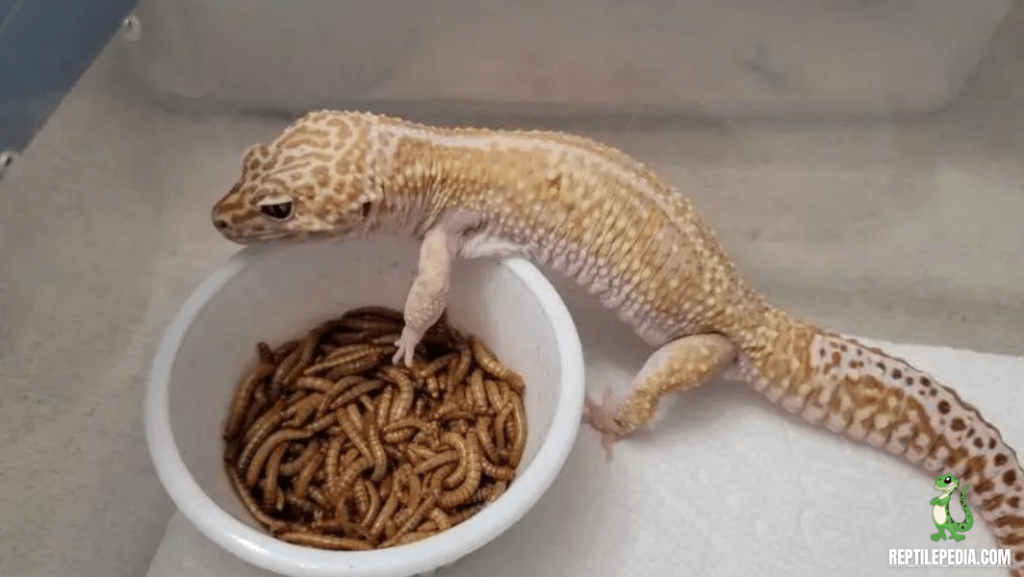
Yes, you can certainly feed darkling beetles to your gecko, but it’s essential to consider their size. These beetles contain a huge amount of nutrients, including protein and calcium, which are vital in preventing metabolic bone disease in geckos. However, their greater and harder exoskeleton can be challenging for geckos to eat. To facilitate easier consumption, it’s advisable to cut down the beetles into pieces. This ensures that your gecko is not eating something too large for its diet.
In their diets, alongside staples like cricket and other insects, mix these cut pieces of beetles with other foods they can easily eat to fulfill their nutrition requirements. For more information on diet questions related to geckos, refer to a detailed diet folder or consult a reptile nutrition expert.
Frequency of Feeding Mealworms to Leopard Geckos
For leopard gecko owners, understanding the feeding pattern for Mealworms is critical. These insects, often cut to one-inch in length, are essential for nutrition at all ages of the gecko. It’s recommended to feed them to your pets as part of a variety of nourishing insects. Leopard geckos should receive a mix of different bugs daily, with Mealworms being a part of the main menu. However, it’s crucial to avoid overfeeding fatty insects like Superworms and hornworms to prevent your gecko from developing love handles or becoming saggy.
A balanced diet can include at least six different types of bugs, ensuring your reptile continues to consume a healthy and diverse range of nutrients. Check out more detailed feeding guides for specific insect proportions and frequencies.
How Much Should A Leopard Gecko Be Fed?
A common question among leopard gecko owners is how much to give their pet. The simple solution varies depending on the gecko’s life stage. Growing, young geckos require much more food than older ones, as do those that are pregnant or recovering. They need ample nutrients, making meals crucial in providing the necessary energy, calcium, and fat. For older adults, a guideline is 5 to 8 insects per feeding, adjusted to the appropriate size for your pet’s size. This typical number should be an amount your gecko can consume in one sitting, and it varies with the size of insects and how frequently you feed them each week.
Other Food You Can Feed Your Leopard Gecko
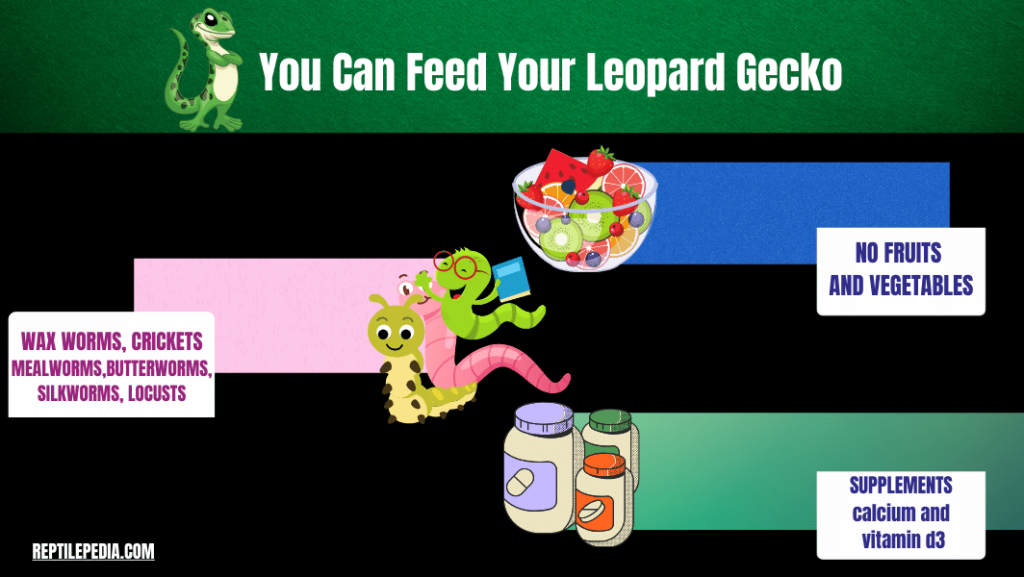
Leopard geckos are insectivores and carnivores, primarily eating insects. Beyond mealworms, common choices include crickets, Dubia roaches, and black soldier fly larvae. A diversified diet is key, but they are unable to consume human foods like fruits and vegetables. Commonly given feeders are Grasshoppers, Superworms, Waxworms, Hornworms, and Silkworms. Each of these offers a variety of nutrients. It’s fascinating how these strange and amazing bugs can be fed to your gecko, ensuring they receive all the essential nutrients for a healthy life.
ALSO READ: Can leopard geckos eat fruit?
FINAL THOUGHTS:
Leopard geckos, like many reptiles, primarily eat insects such as crickets. Their diet should be rich in chitin, but it’s crucial to note that the chitin in a mealworm beetle can be difficult for them to bite and consume. Offering these beetles right after hatching is an excellent approach, as they are considerably softer and easier for geckos to eat. Incorporating a calcium supplement can also increase the nutritional worth of their diet.
It’s advisable to refrain from giving your pet wild-caught insects, as they may be contaminated with chemicals or diseases. To ensure a steady supply of nourishment for your gecko, consider creating a mealworm colony, which can be easily managed at home. This ensures that your leopard gecko has access to fresh, safe, and nutritionally adequate food at all times.
FAQs:
-
Do mealworm beetles bite?
Mealworm beetles can bite, but their bites are generally harmless to humans. These beetles have mandibles strong enough to nibble on decaying leaves, grain, and soft woods. While their bite might be surprising, it rarely causes more than minor discomfort and is not a concern for most people.
-
Can leopard geckos eat buffalo beetles?
Leopard geckos can eat buffalo beetles, also known as lesser mealworm beetles. They are a suitable food source, providing good nutritional value. However, it’s important to feed them in moderation as part of a varied diet, ensuring the beetles are appropriately sized for the gecko to prevent any feeding difficulties.

